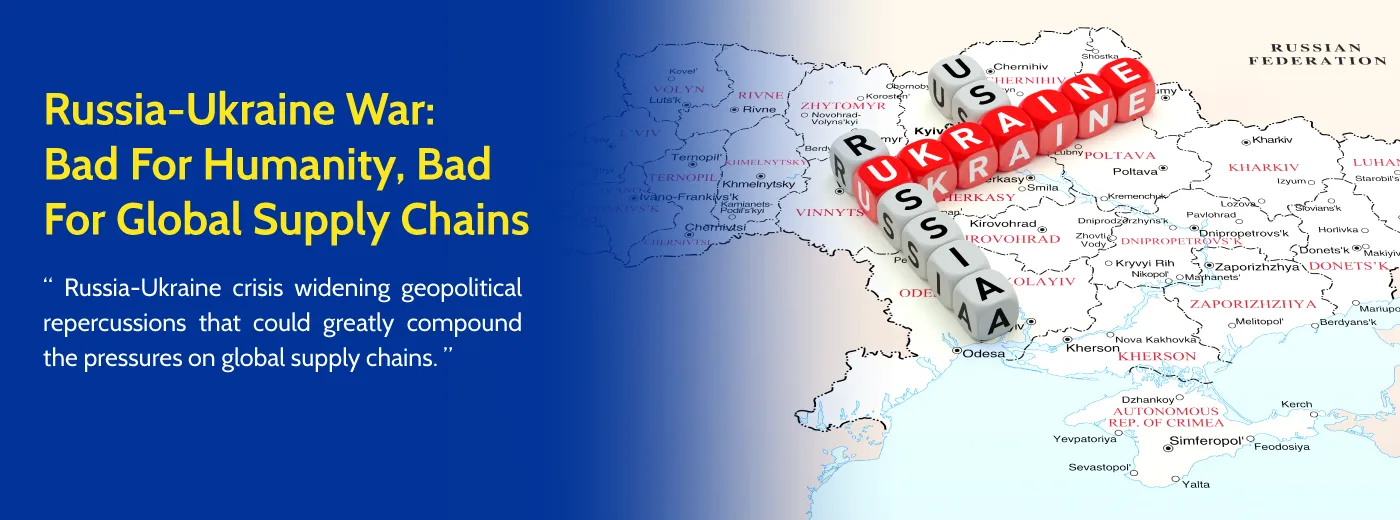"To avoid, absorb, and recover from the disruptions caused by geopolitical conflict, supply chain leaders must gain visibility into all tiers of their network, especially tier-1 suppliers." - Gartner
Ukraine and Russia have been marked instrumental to the health of global supply chains and the news floating about Russia's near at hand invasion of Ukraine spreading fast as a wildfire. The global supply chains are yet to recover from the pandemic shock entirely — and a series of unforeseen events last year like the blockage of the Suez Canal — before the attacks began early Thursday morning in Ukraine.
According to a report, more than 1,100 US-based and more than 1,300 Europe-based organizations are dealing with Tier-1 suppliers in Russia, and more than 400 companies in both Europe and US are tackling Tier-1 suppliers in Ukraine. Moreover, from both Russia and Ukraine, more than 1,000 firms in Europe and the US have Tier-2 suppliers in place, while around 1,200 US and Europe-based firms are involved with Tier-3 suppliers. Dissecting based on services that the US and Europe receive, 12% software & IT services, 9% trading and distribution, and 6% oil and gas come from Russia and Ukraine. Additionally, steel and metal products are other common items.
From a bird's eye view, the impact of Russia marching into Ukraine will not be limited to the Ukrainian borders. The global supply chains are dreading experiencing a significant blow.
Mounting Up Wartime Supply Chains
If we look long-term, it is hard to predict how the situation will develop. This level of aggression is not seen in the post-war era in Europe. As per the current situation, the possibilities range from full-scale armed conflict to severe economic sanctions creating volatility and impacting production capacity and critical logistics routes. As per this Gartner report, this could have a substantial immediate and medium-term effect on global supply chains. The fears about materials' availability will be amplified. Even a standstill positioning would drive further unpredictability into supply chains, especially in critical industries such as semiconductors, energy, and high-tech electronics.
Unfortunately, it's bad news for supply chains that rely on safety and are so interconnected that a single problem could cause significant issues. Let's look at some of the critical issues that supply chain leaders will have to deal with:
- Key material shortages
- Impact on Production capacity
- Material price heights
- Demand volatility
- Cyber security collateral damage
- Logistics route and capacity constraints
How should leaders halt these Supply Chain Disruptions?
Numerous risks related to planning disruptions may not materialize and represent a worst-case scenario. But leaders should think in-depth about the potential impact of a military conflict between Russia-Ukraine. These leaders are required to ensure appropriate contingency plans for their most critical supply chains and riskiest suppliers in the region. Risk mitigation strategies include:
- Estimating required levels of inventory and labor in short to mid-term
- Discussions on business continuity plan with crucial suppliers; and
- Preparing to qualify, or switch to alternative sources for essential products and services
With complete planning, analysis, and execution, it is possible to mitigate significant risk, ensure operational resilience, and avoid supply chain disruption.
Protecting supply chains from future geopolitical dissensions
There are always adequate ways to monitor an organization's risk appetite and risk management capabilities. Resilience drivers, such as diversifying routes and sources where possible and preparing risk response plans for the most fragile supply chains, are crucial/ In the long run, supply chain leaders must accelerate resilience by balancing investments in dedicated processes, teams, and technologies that will allow their enterprises to implement end-to-end risk management. This involves tactics such as positioning strategic redundancies that drive competitiveness and secure significant value networks and supply ecosystems.
Wrapping Up
Henceforth, in such turbulent times, thorough planning and analysis are only possible if all the business leaders are on the same page, a connected enterprise planning solution help supply chain leaders to strategically transform, redefine, and innovate planning across the organization—win during the disruption and build agility into decision-making by pushing the boundaries of the supply chain.
If you like this blog, let's talk more about Supply Chain Analytics solutions. Book a demo.



